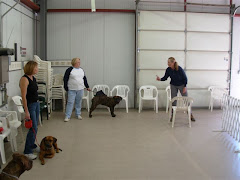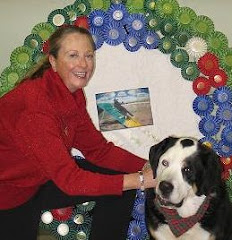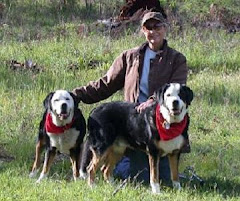Jan,
As of this weekend we have a new dog. Pepper is an 8-year-old Mini Schnauzer. My daughter got her from a rescue shelter in Indiana when she lived in Chicago. Pepper had been bred about 10 times and was just kept in a 2 x 3 box w/a wire bottom. She couldn't even walk in a straight line at first, she just walked in circles. Now she runs in the side yard and even smiles. Rose already has another Schnauzer and thought another one would keep hers company. But her original one doesn't want company and was aggressive to Pepper. So Pepper lives w/us. Problem is that pepper isn't house broke. She is terribly afraid of a leash, too. Her teeth were all decayed and so Rose had them taken out this fall. Rose is having me feed her Innova. Have you ever heard of it? Poor little thing is actually doing well, considering all the bad stuff happening in her life. She is exceptionally loving and adores to be brushed and cuddled. Any ideas on teaching adult dogs to "take it outside"??
--Susan
Susan,
Congratulations on the new family member, and on adopting a rescue. They are among the most rewarding of pets.
Pepper sounds like she was a non-socialized puppy mill dog who never got the nurturing she deserved, so now she's enjoying it. But she also needs the socialization. That means teaching her how to deal with real life. And that includes a leash, which is her key to the outside world. So here's what I'd do....
1. Attach a lightweight four-foot nylon leash or rope to her. Let her drag it everywhere, inside and outside (supervised, of course, so she doesn't get stuck on anything) and take it off only if she is left alone or when you go to bed. That will desensitize her to the leash. Obviously she needs a collar too. Start with a plain, simple buckle collar. Leave it on her whether she "likes" it or not. Same with the leash. If she acts fearful or resentful of either leash or collar, do not acknowledge her feelings. If you try to comfort or console her about the leash, you will only make matters worse by feeding into her anxiety.
2. Occasionally pick up the leash and coax her to you with a soft treat. Teach her that she can move TO you and WITH you on the leash, without fear.
3. When she seems acclimated to the leash, collar, and you (which could take a week or two), fit her with a slip-collar (choke chain). She'll probably need about a 16" collar. Get it at Manning Dog Training so you know it fits properly. Now you'll be attaching the leash to the slip-collar and giving it a very light "zip" to get her attention and encourage her to move with you. Keep using treats to reward her for her movement and to help her gain confidence. Go slow and don't expect a lot. A trip around the back yard, or up and down the sidewalk in front of your house is a good start. The slip-collar will communicate with her in a subtle yet more natural way. Plus, if she gets scared and bolts, she won't be able to pull out of it as she might the buckle collar. Keep the buckle collar on her too, since this should hold her identification tags. But the leash should be attached to the slip-collar.
4. When you walk with her, be patient and kind, but do NOT try to comfort and console her if she gets fearful or starts to balk. Just keep walking. Show her through YOUR ACTIONS that there is nothing to fear.
5. Re. the housebreaking....treat her as if she were a nine-week-old puppy. You may think it's best to keep her out of crates, but remember that this is all she knew for a long time and will probably take comfort in a crate's familiarity and security. So continue to crate her at night and any time you cannot be supervising her in the house. She won't potty in the crate, and therefore won't have the chance to potty in the house and make a bad habit of it. When you CAN supervise her in the house, keep her within sight at all times. Do NOT give her free access to the house, and do NOT let her sneak into the other rooms out of sight. In other words, don't even give her a chance to go to the bathroom in the house. You will regulate when she goes to the bathroom by taking her out at appropriate times and watching her do it (so you know for sure she went). If you take her outside and she does not go potty, bring her back inside and re-crate or for a few minutes before trying again. This will prohibit her from entering the house and pottying as soon as she gets inside.
6. Get some Nature's Miracle to eliminate the odor and stain in the carpet where she's had accidents. Don't waste your money on ANYTHING ELSE. Get ONLY Nature's Miracle. No vinegar, no Simple Solution, no carpet cleaner. None of them do what N.M. does. You will need this to break down the smells that may draw her back to the same spot to re-offend. Get N.M. at any pet store or feed store, but it costs a lot less at Manning Dog Training. A quart bottle is about $7.50 there.
7. Remember that habits take about three weeks to form. You'll need to keep up this "Housebreaking 101" routine for AT LEAST 3 weeks to re-program Pepper.
8. I'd also suggest you attend Jane's "Puppy Parenting Class" at Manning Dog Training. Call 574-4008 for a schedule. It's a once-a-month, one-night class for people with new dogs. Even though Pepper is 8 years old, you're still having to do puppy-style training with her, and this class will address many more problems for you before they even come up.
9. Innova is a very good food. Do you soften it first with water? Does Pepper like it? An alternative is Flint River Ranch "Drywater," which is a dehydrated preservative-free food that reconstitutes with warm water into a meaty, aromatic stew with vegetables and probiotics. It is ideal for older dogs or dogs with teeth problems like hers. And it smells so good you could feed it to your husband!





2 comments:
Hi Jan, I am curious why you would recommend a "slip collar" when the dog doesn't have any on leash issues as she's never been on a leash prior to being rescued?
Dogs can easily "back out" of traditional collars if they become excited, startled or stressed. A dog will put on the brakes or even move backward when she's startled. The handler's natural reaction is to pull the leash (with dog attached) FORWARD. The dog struggles against this and suddenly frees himself of the collar. Now we have a terrified dog who is also LOOSE. That's why I recommend some type of slip collar or slip leash. You can't maintain control unless you already have control.
Post a Comment